New Products from Taipei Cycle 2025
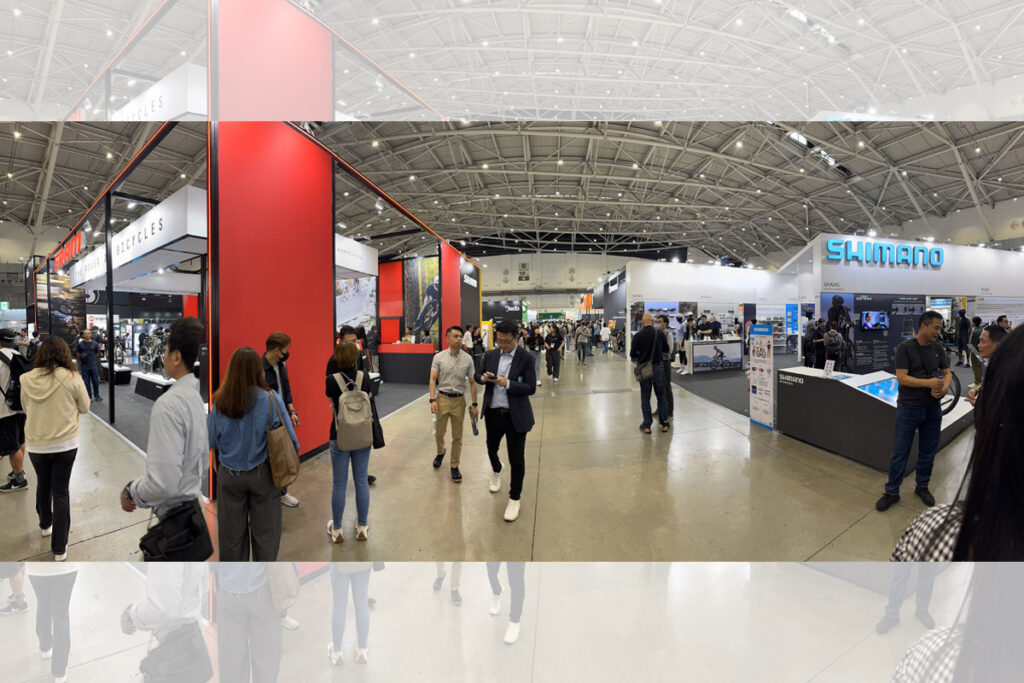
Taipei, Taiwan
Each year members of the bicycle industry from around the world gather for the annual Taipei Cycle exhibition.
It’s a big show! By the numbers, visitors saw 980 exhibiting companies filling about 60,000 square metres of space across three huge exhibit halls.
Taipei Cycle doesn’t just showcase Taiwanese manufacturers. There are dozens of international exhibitors from around the world who are visited by the thousands of international buyers who attend each year. Taipei Cycle is primarily a trade show, as compared to a consumer show like Sea Otter.
At the time of writing, show organisers had still not released the official attendance data, but it felt slightly quieter than last year, both during the three trade days and on the fourth day which is also open to the public.
That’s reflective of 2024 being another really tough year for both the Taiwanese bicycle and global bicycle industries. Taiwan’s export numbers were down and bicycle industry manufacturers have been feeling the pinch. But there was still a sense of optimism, with early 2025 numbers from Giant and Merida showing a monthly increase, year on year, from last year.
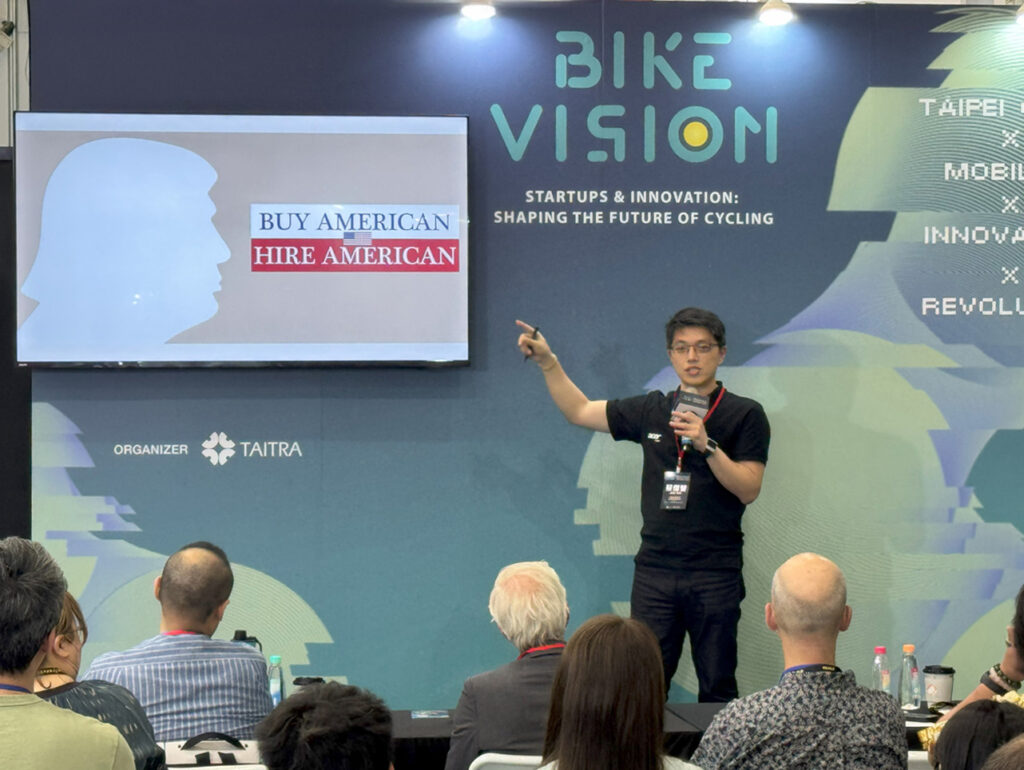
The Taiwanese are incredibly resilient. As if the ever-present threat of invasion from mainland China is not enough, their bike industry is now wondering what the fall out of “Trump Tariffs” will be.
One very articulate and optimistic presenter suggested that if the Taiwanese bicycle industry set up more American-based manufacturing and bought more from America that Mr Trump may spare them from the worst of these uncertain and concerning tariff barriers. I hope for their sake that he’s right, but I haven’t seen The Donald riding a mountain bike lately, so it remains to be seen if he would notice or care what the Taiwanese bicycle industry does…
Below is a summary of some new and interesting products that I saw at this year’s show. Of course, “interesting” is a subjective judgment and I’m certain to have missed some things that other media members thought to be newsworthy. I walk up and down every aisle “lawnmower style” to go past and look at every booth. For every innovator there are often a dozen “Me too!” copies in other booths, so finding what’s genuinely new is the thrill and reward of the chase.
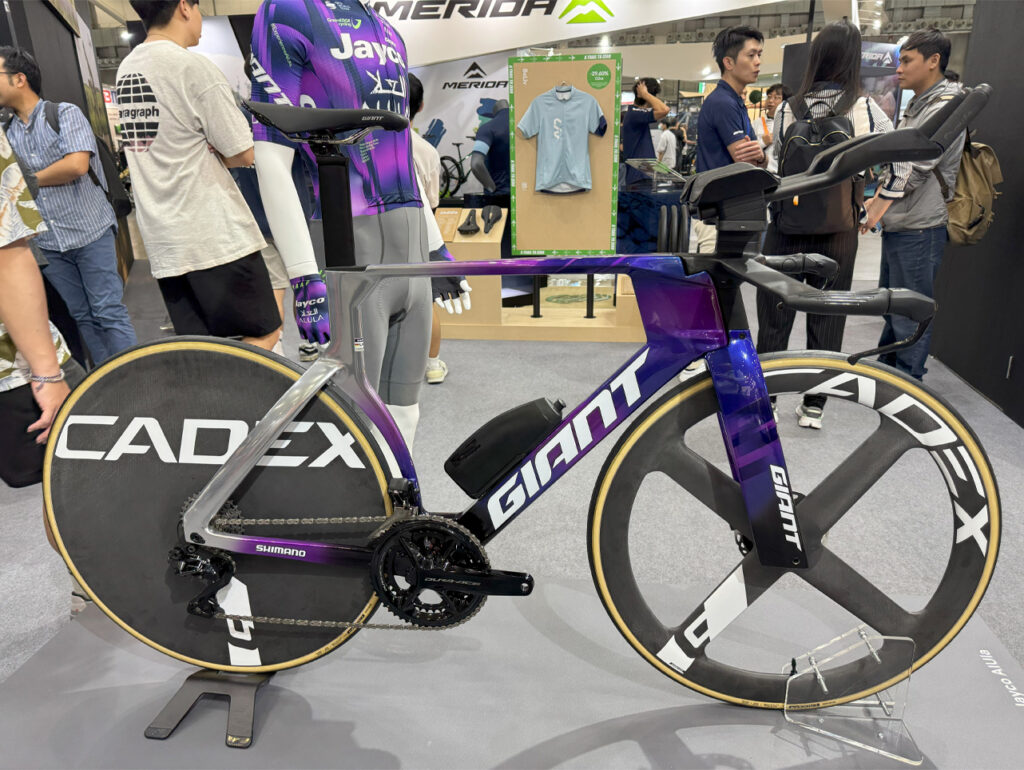
Australia’s Jayco team was heavily featured in the Giant booth with this new Trinity time trial bike and the new team kit from Australian apparel brand MAAP.

This is the new third generation Tern GSD, which most agree was first bike in what is now called the “compact cargo” category. It features Bosch smart system drive that includes GPS tracking and eBike alarm, anti-lock brakes, a new detachable rear rack system and a range of other enhancements over the previous model. It can handle a total weight of 210 kg – bike, rider plus passengers and cargo.
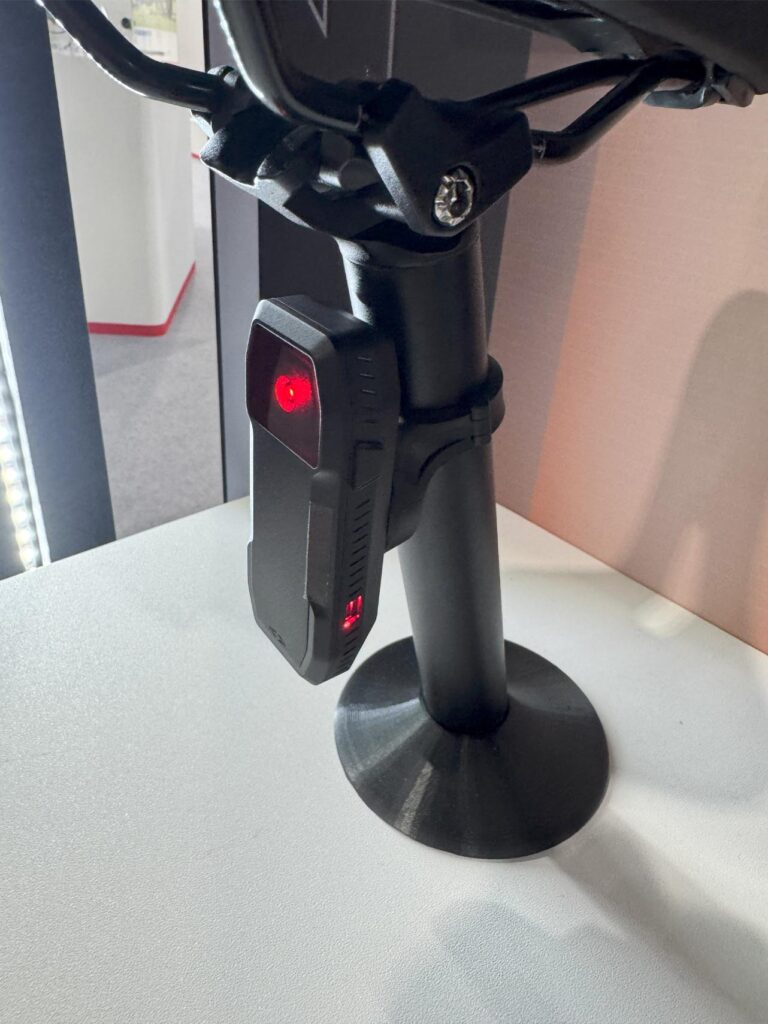
Radar systems like this new one from TransX are becoming both more common and cheaper. This one can detect vehicles coming up behind the rider from a distance of up to 150 metres. It has options of a dedicated handlebar mounted display or linked to your smartphone via ANT+ or Bluetooth. The FOB (ex factory) price is US$50 (A$80).
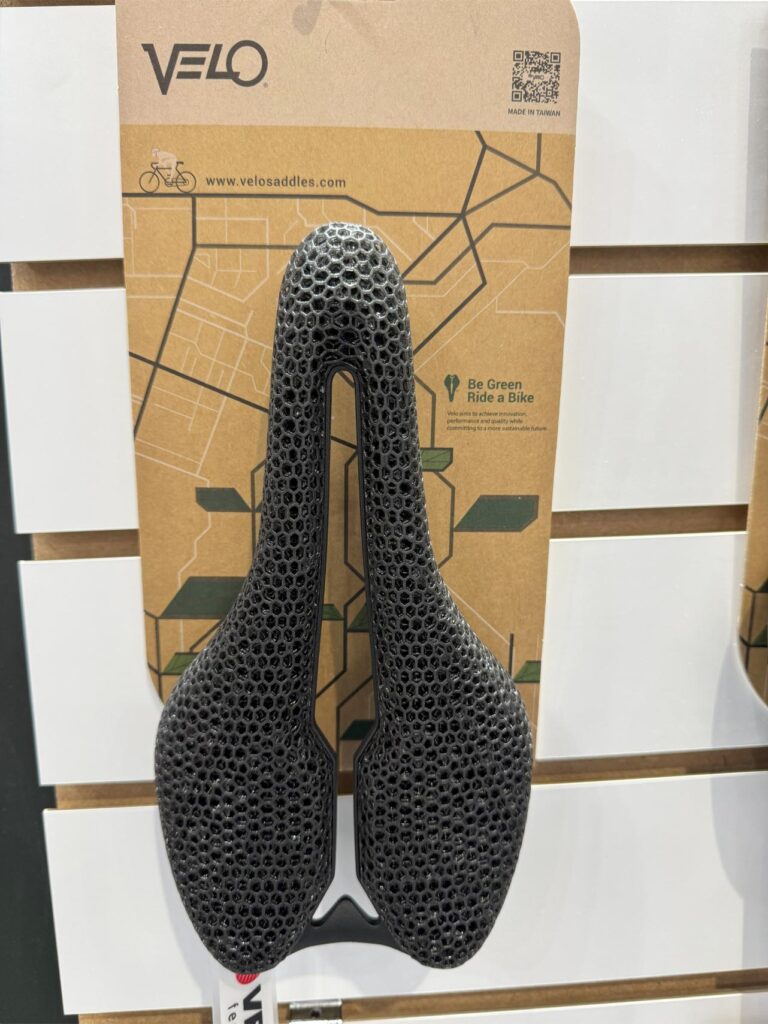
Velo says that they’re seeing growing demand for their 3D printed saddles that enable designs impossible to make via conventional manufacturing methods.
Velo also owns Prologo, their high end performance saddle brand used by many pro-road teams including their newest partnership with Visma Leaseabike.
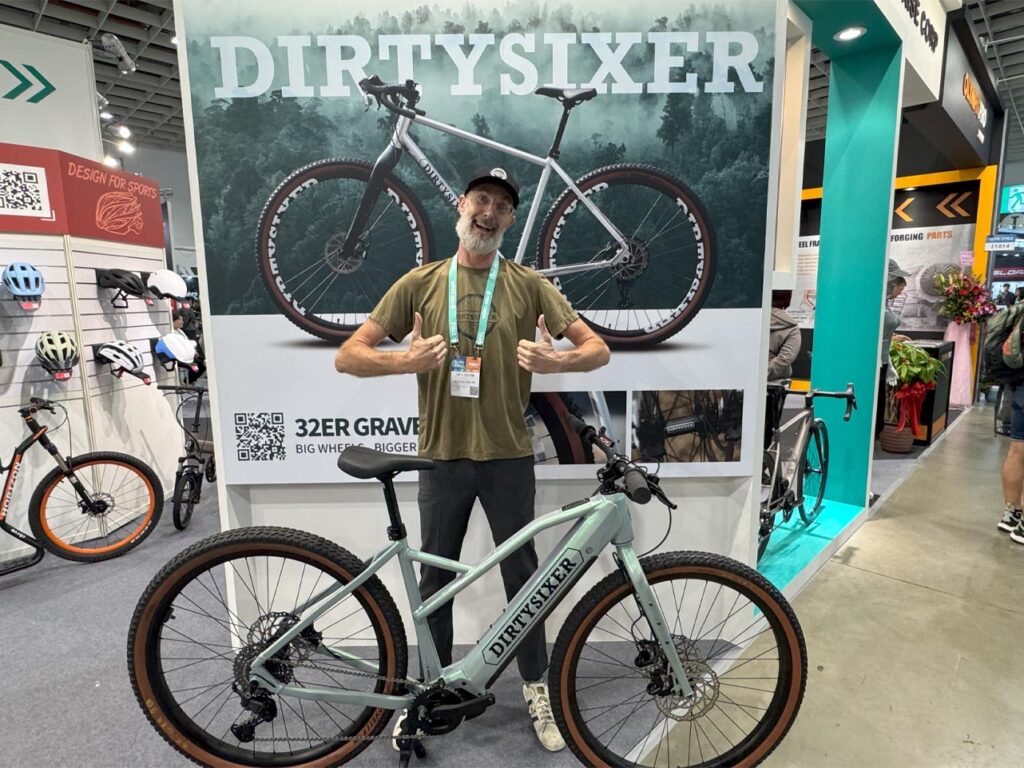
Tall Order
This is David Folch, the French-American inventor of the 36er mountain bike that was born back in 2013. His brand is Dirty Sixer because Americans in his adopted home of San Francisco, California couldn’t understand his French accent when he was saying “Thirty Sixer”. They thought he was saying “Dirty Sixer” and the name stuck.
Fast forward to 2025 and David has a new MTB platform with 32 inch wheels. He said that even 29er’s can be too small for really tall riders, because their weigh distribution ends up being too far back when they have to use a huge seatpost at conventional, laid back frame angles.
David is 198 cm tall and some of his customers are even taller, including basketball stars such as LeBron James, Kevin Durant and Shaquile Oneil.
His new 32 is gathering momentum. Maxxis are about to come out with a 32 x 2.4 tyre and he says Trek have also shown interest in this wheel size. The bike photographed here is more of a trekking e-bike, but David said there are gravel and MTB 32 inch models coming “very soon”.
His bikes also have twin front disks because his customers can be 150kg or more and he says they like the security of the extra braking power.
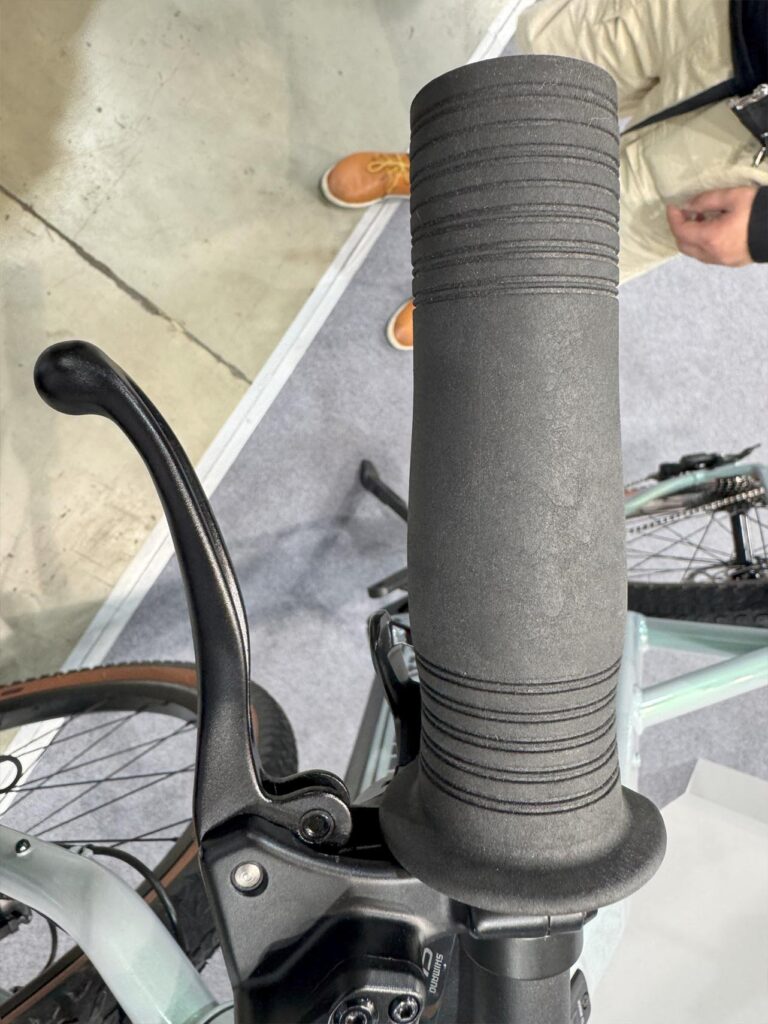
Oversized Grips
An overlooked detail about extra tall people is they typically have huge hands. For them, holding a standard sized MTB grip is like trying to hold a toothpick! Therefore, Dirty Sixer makes these ginormous grips that are both slightly longer and about 50% fatter than standard grips. These can be bought as an aftermarket product for any MTB.
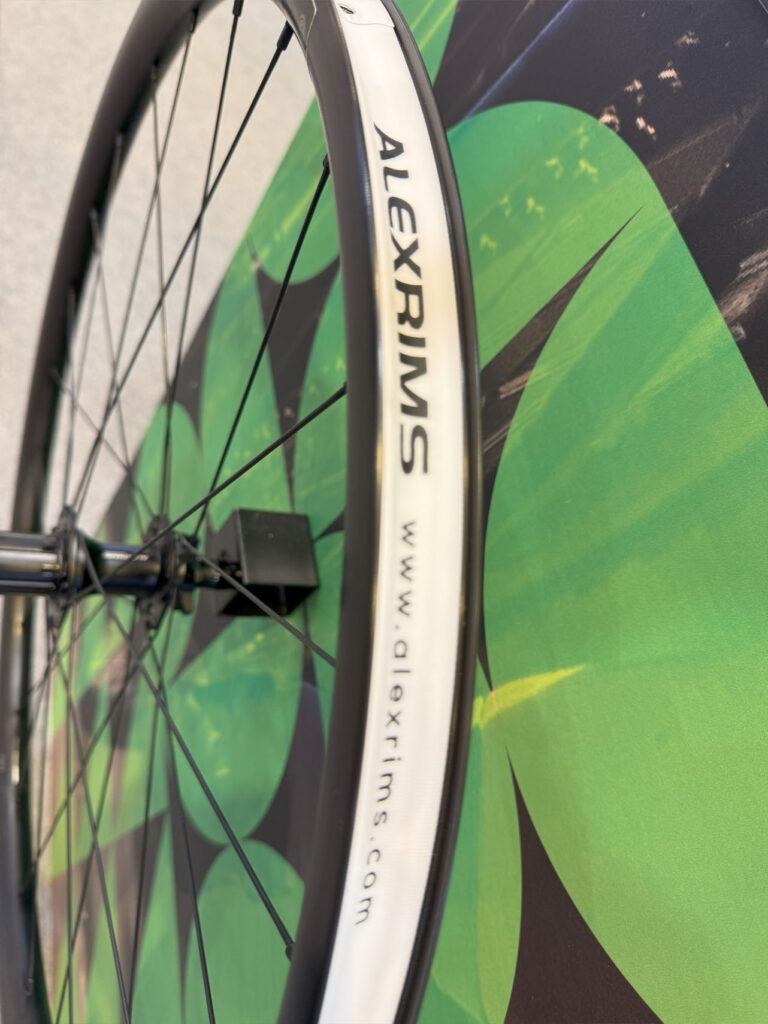
Wider Rim Trend Continues
These new Alex G7 gravel bike wheels come in 23 mm and 25 mm options. Previously their gravel wheels typically only had 21 mm wide rims. They said that it’s part of an ongoing trend towards wider rims, that has followed the trend towards fatter tyres.
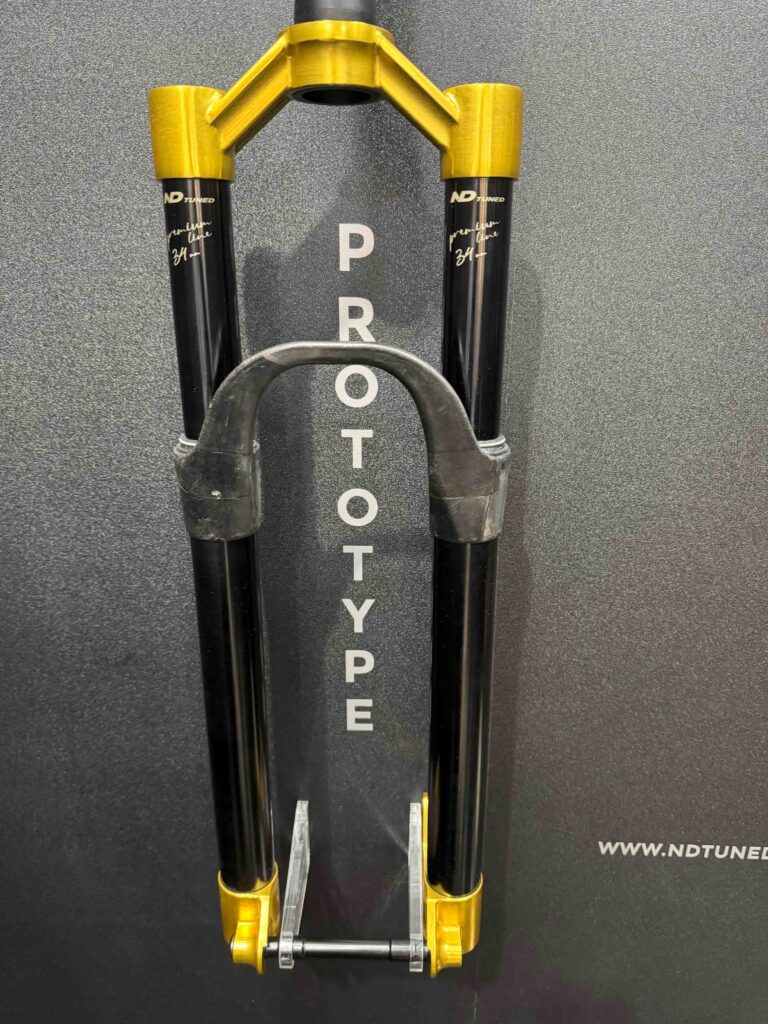
High Tech MTB Suspension
Nuno Duarte is a Portuguese based suspension designer whose passion and expertise was immediately obvious when he started explaining his new products in a rapid fire crescendo of technical details.
Nuno has built his company and expertise through more than 15 years of suspension maintenance, starting with servicing his local market, followed by creating and supplying suspension service kits, specialist tools and parts to expert MTB suspension centers around the world including five of the leading Australian ones.
Now he’s launching his own suspension forks and rear shocks. His prices are comparable to high end Fox and RockShox models, but not surprisingly, he can explain in great detail why his products are better.
These front forks weigh just 1.35 kg for the 34 mm version. He also has a carbon steerer tube option at about 1.2kg.

Nuno’s coil spring rear shocks weigh approximately 620 gram, which he says is lighter than some piggyback air shocks from other brands.
He says his shocks eliminate pedal bounce because they use a negative spring and have a patented dual flow valve / dual positive chamber system – one low speed and one high to make the full range of travel more usable and reduce sag and ramping.
Perhaps a less important feature to some, his shock shafts stay black because he’s developed a special 2x hard coat treatment.
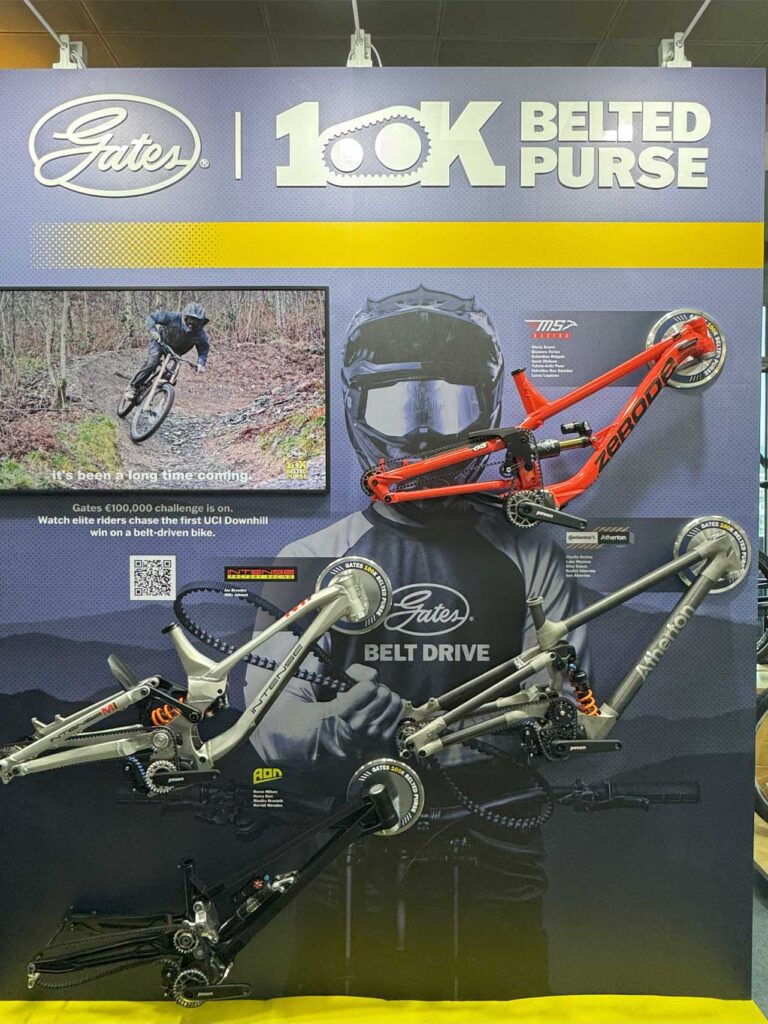
Still at the Starting Gates
At the start of last year’s season, Gates offered €100,000 (A$174,000) for the first team who could win a downhill World Cup round riding a Gates belt drive. Although no-one took the money last year, the prizemoney is back on the table this season and twice as many teams are riding Gates belt drives.
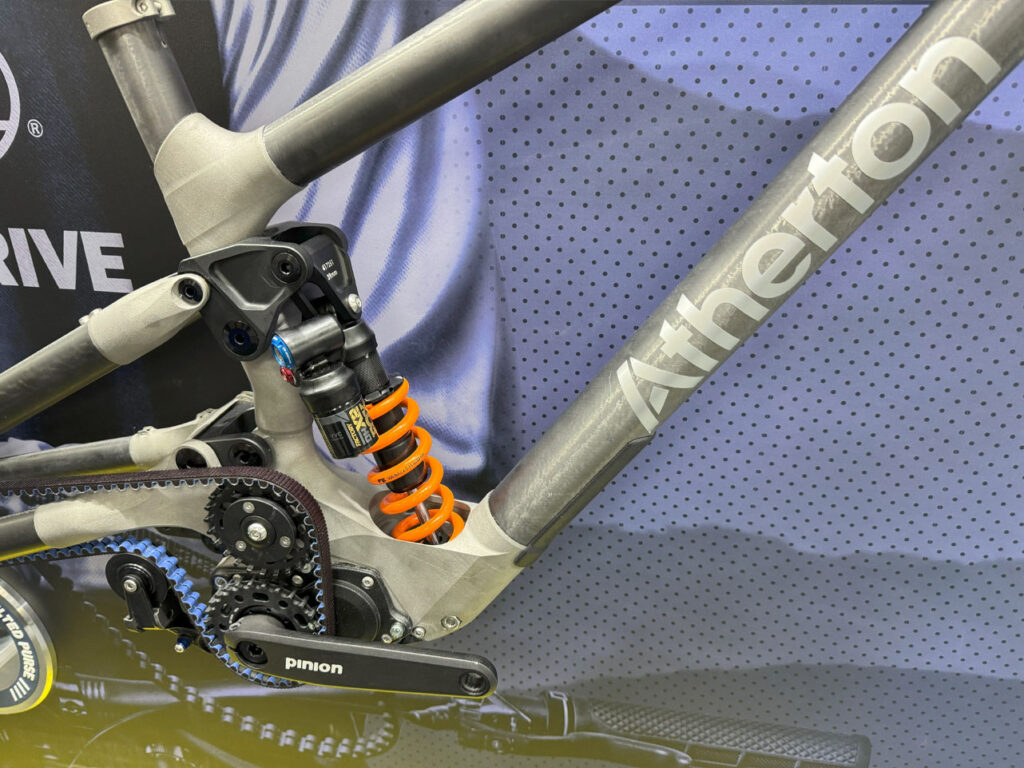
The fabled Atherton team from the UK is one of the additional teams running Gates belt drives this year, teamed with Pinion internal gear boxes. Gates claims advantages of their belt drive system for MTB racing include less unsprung weight at the rear wheel, higher tension than chain drives, eliminating chain slap, no need for wax, oil, degreasers etc and better mud tolerance – the belts wash up with water.
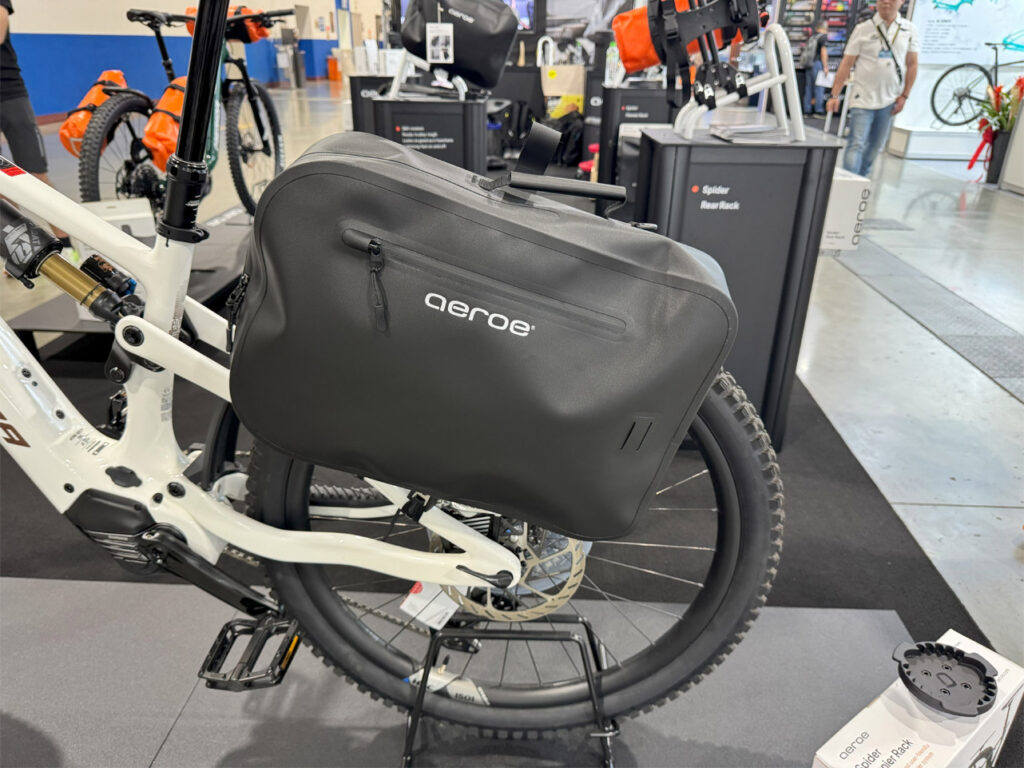
Kiwis Conquering the MTB World
Brothers Mike and Paddy Maguire are an “overnight success” that took more than a decade of hard work and product development. They founded Aeroe in their home country of New Zealand but now have global distribution and a growing team of staff including one in the UK.
In a crowded bag and rack market, Aeroe differentiated themselves by focusing solely on MTB’s.
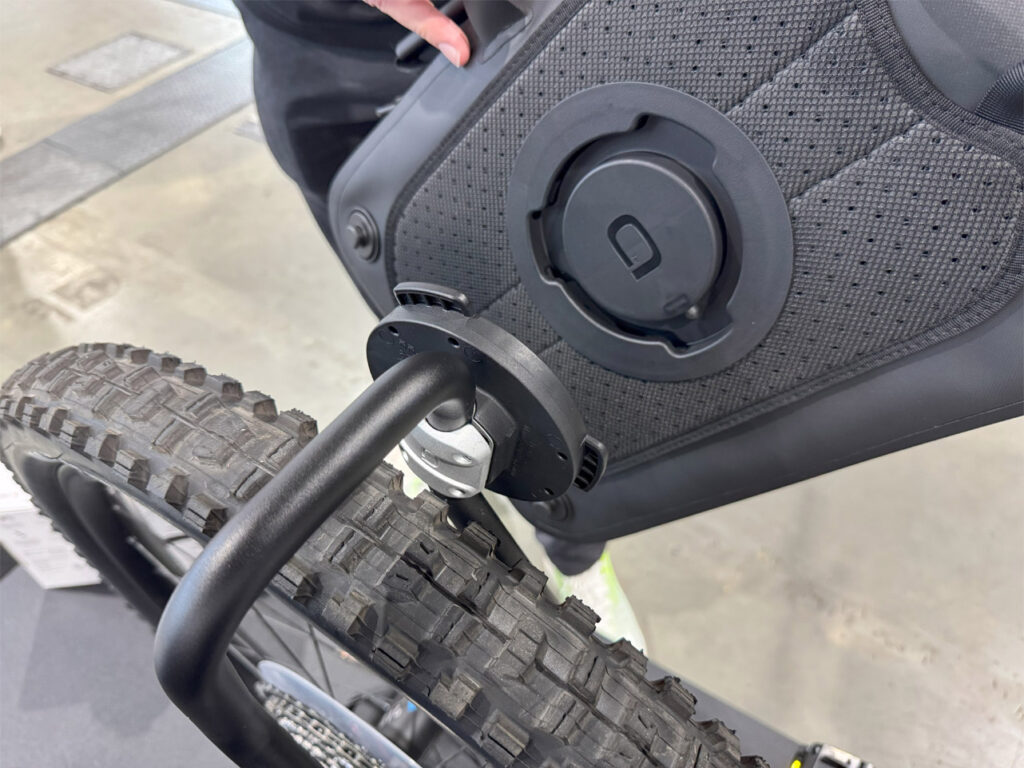
This is their new, patented Quicklock attachment system. It fits onto their original Aeroe racks which are unchanged from previous years. The bag itself uses magnetic click on straps that can be configured in multiple ways to make it a messenger style bag or tote in addition to the bike pannier mode shown here.
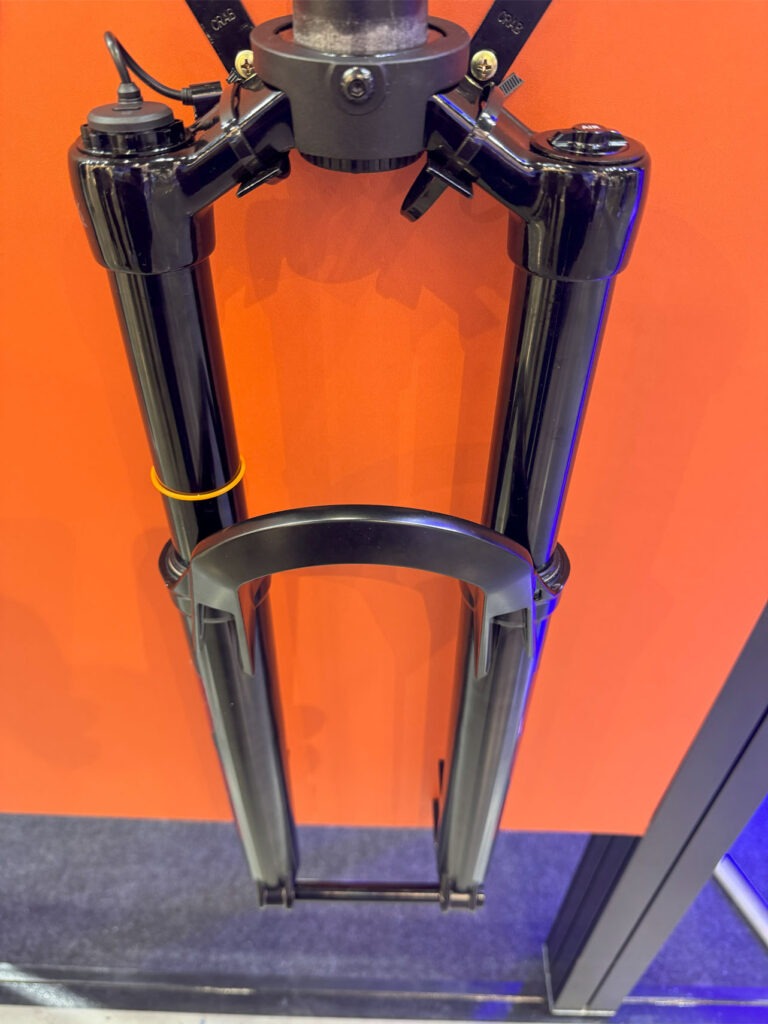
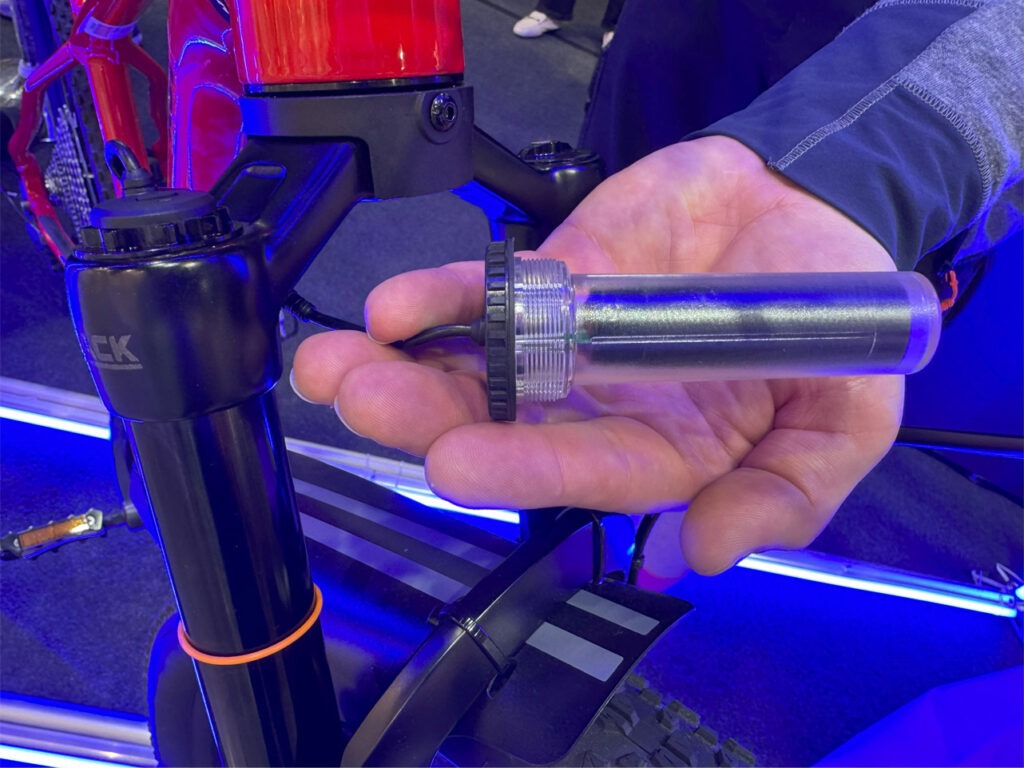
New Electronics Finally Making Things Viable
RST developed their first wireless suspension controller back in 2010, but the electronics required were too expensive in those days to make a viable product.
This year they showed this model, not yet in production. The wire only goes as far as the steerer tube where the surprisingly large battery is housed. If being used on an e-mtb, then the system could be powered by the main battery with no need for this specific one.
This E TACK is linked to a speed sensor which can adjust the fork from full lockout to full open with at this stage only one intermediate position. This is done via a small servo unit inside the fork leg.
The E TACK handlebar mounted control system wirelessly operates both the fork and suspension seatpost. It includes an automatic mode that automatically adjusts the suspension settings for both so that riders can “set and forget”.
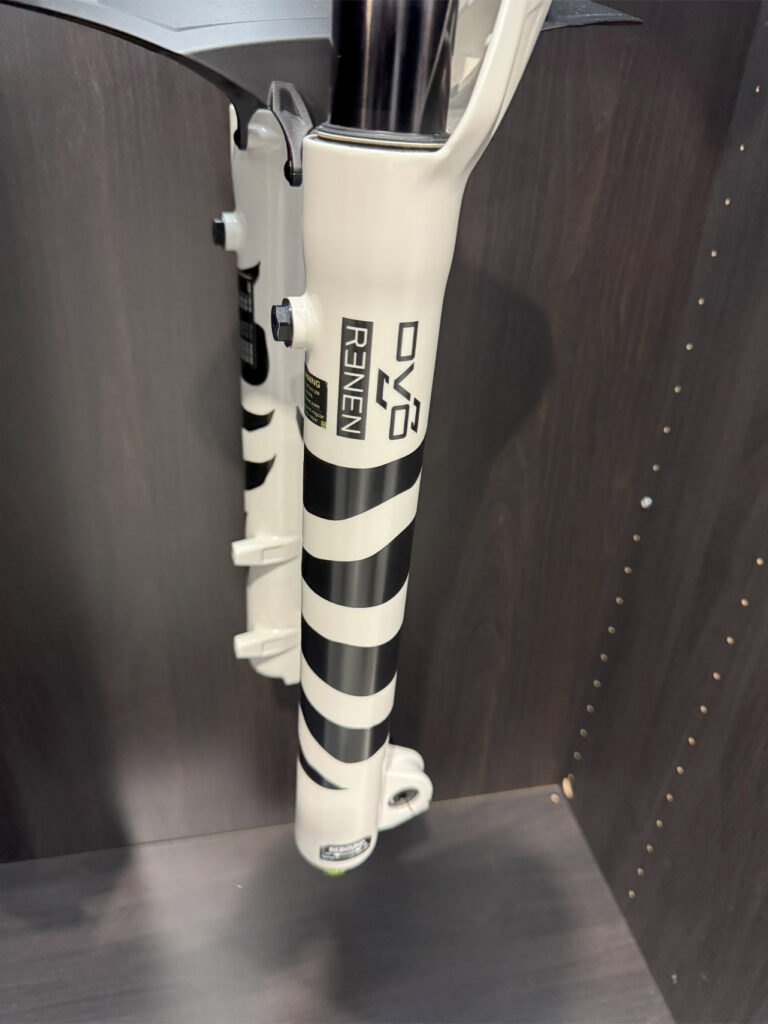
Making a Fashion Statement
DVO is a USA based suspension brand with close links to their manufacturer, SR Suntour.
They’ve recently began offering custom paint designs on their suspension forks for a premium of US$100 (A$158). This example is for Renen – an apparel brand started by Pete Fox, formerly of Fox Racing. This fork matches one of their apparel designs.
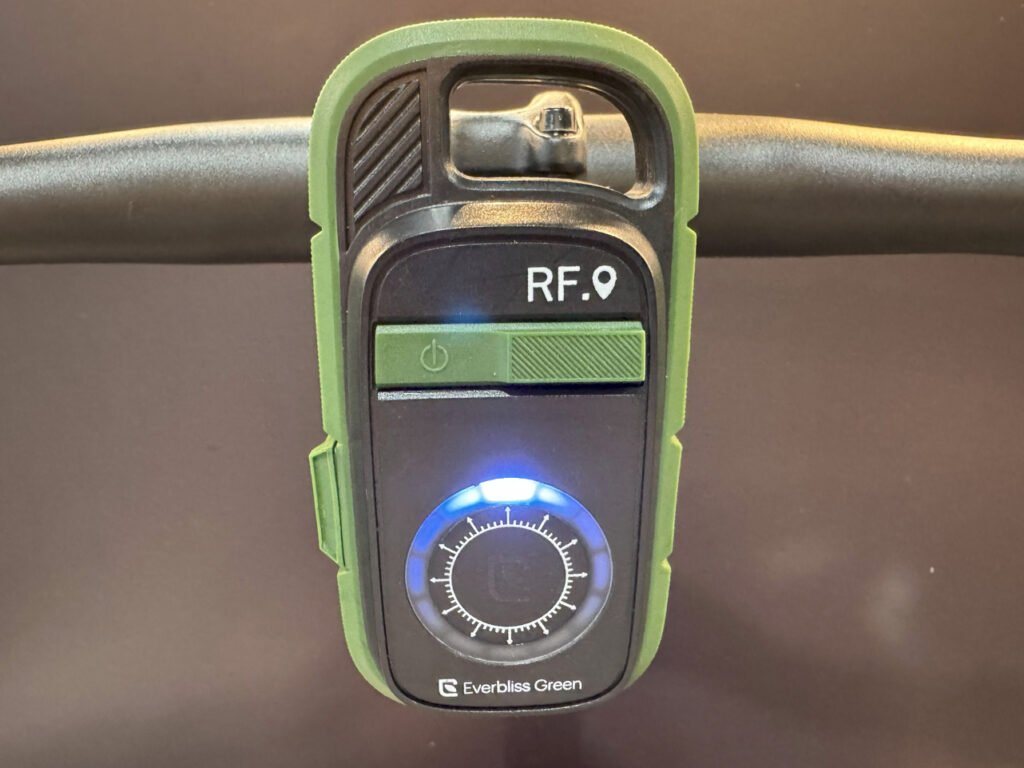
Saving Lives on Remote Trails
This new communication and GPS tracker is not a “walkie talkie” but is a communications, crash sensor and location finder device that could save the lives of riders on remote MTB expeditions.
It can link up to 16 riders at once, with a range of up to four kilometres – without needing any internet connection. If any rider falls and cannot touch their device within five seconds, it automatically sends an alert to the other riders. It uses radio frequency to send “packages” of data which allows it to be smaller and lighter than if it facilitated direct voice communication.
It will retail for around US$350 (A$555) per unit.
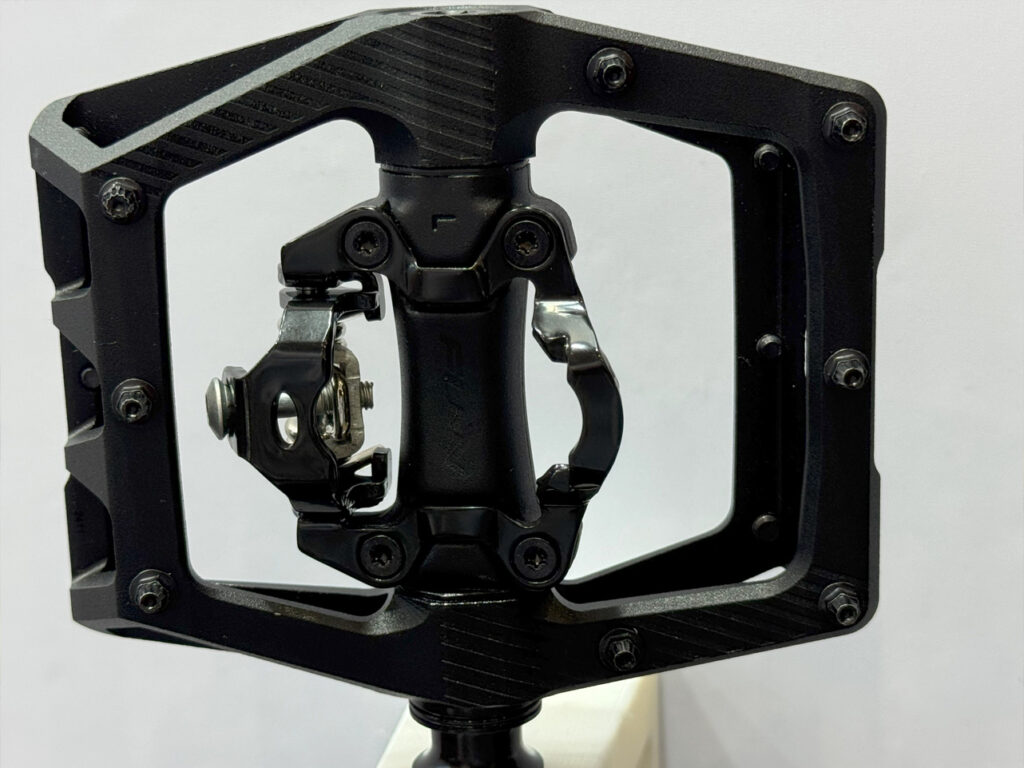
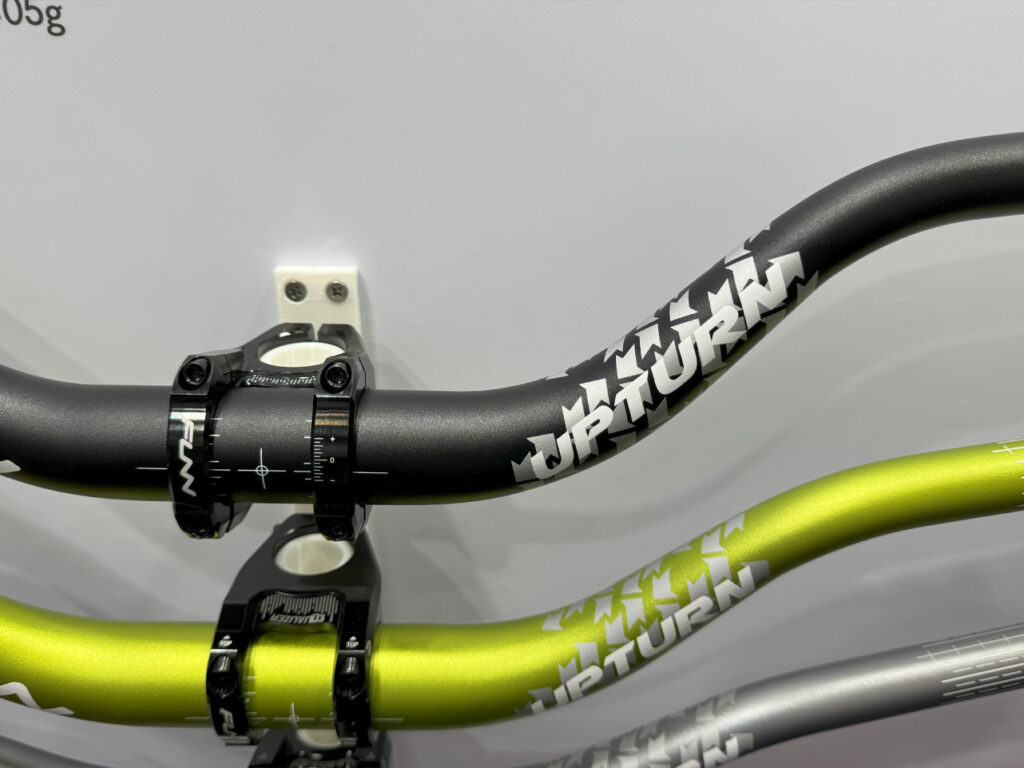
More Funn
Funn were displaying a new single sided Ripper 2 pedal in which the SPD compatible section is spring loaded to sit at a 15 degree angle to the platform section, for quicker cleat engagement. Last year’s model sat flat and they got rider feedback that it was harder to engage.
It weighs 428 grams per pair and will retail for US$149 (A$236) with a double sided version also available for US$10 (A$16) more.
They were also showing new High Rise Upturn bars with a 35 mm diameter.
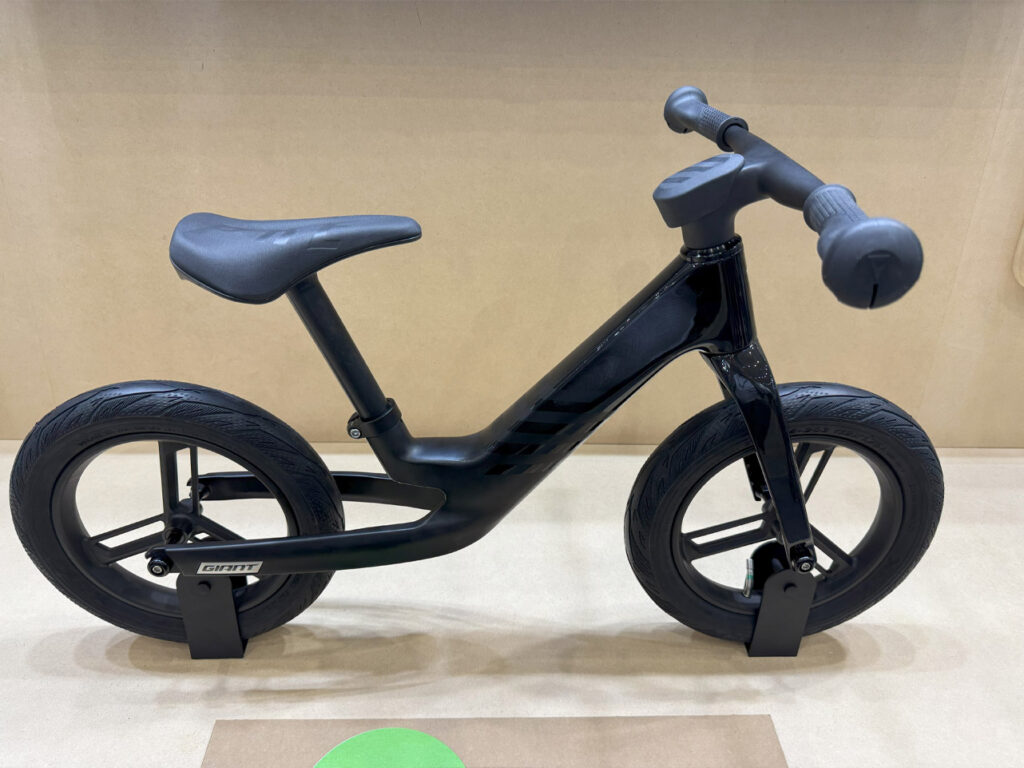
Never Too Early for Carbon!
Giant now have a carbon fibre balance bike for the ultimate doting dad to give to their very young child, at a cost of US$500 (A$793).
Rather than a gimmick, this product’s development has been used as a test exercise for Giant to see how far it can push the recycling envelope.
The tyre casings are made from discarded ocean plastic. The saddle top is made from recycled EVA (ethylene vinyl acetate). The grips are made from discarded polypropylene and recycled thermoplastic rubber. Finally, the frame is made from recycled carbon fibre.
Overall Giant says the bike is made with half the carbon emissions than a comparable bike using all new materials would require.
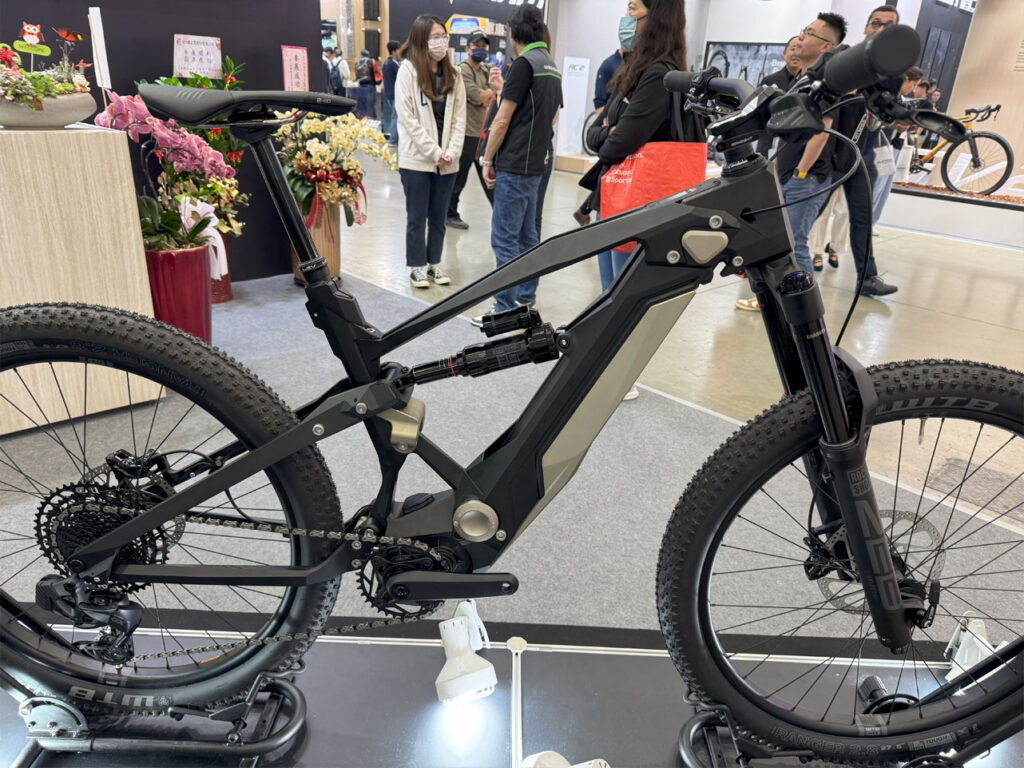
Is That Ideal?
A backbone of Taiwan’s bike industry for decades has been “contract manufacturing”. Ideal is one of a leading tier of about half a dozen frame building and bike manufacturing companies that most consumers will never hear about, because the bikes they make feature the decals of the famous European and American brands that are Ideal’s customers.
These manufacturers are usually coy about which specific brands and models they’re building for. Even Taiwan’s biggest manufacturers, Giant and Merida, built their companies by making bikes for many other brands and continue to do so to this day.
Therefore, if this prototype ever ends up in production, it won’t be wearing an Ideal decal. But it was a beautifully finished MTB in which every frame part was CNC machined and bolted together. The entire frame can be unbolted and shipped in a suitcase.
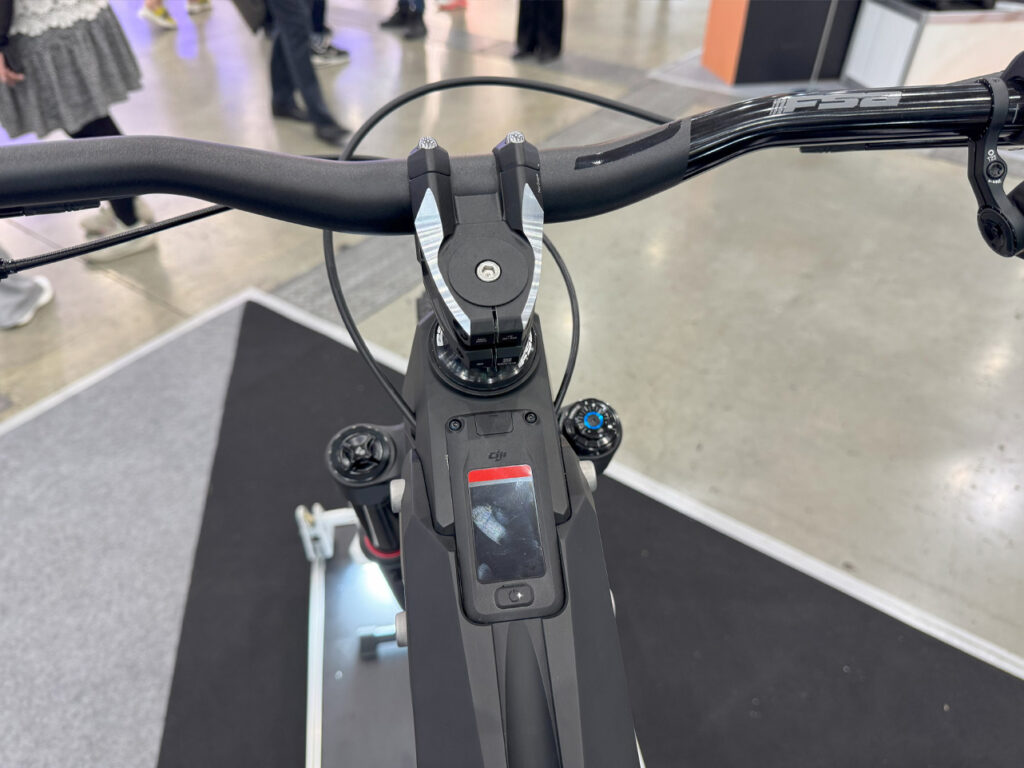

DJI, which caused a big stir at Eurobike last year, did not have a booth at this year’s Taipei Cycle. But their Avinox drive system featured on this Ideal prototype. A spokesperson on the stand said that they are working with a couple of leading brands on DJI equipped models.
Another “well informed source” predicted that USA brand Transition will be the first to join Amflow with a DJI equipped bike in the marketplace. It’s possible that more was to be revealed at Sea Otter in California, two weeks after Taipei Cycle.
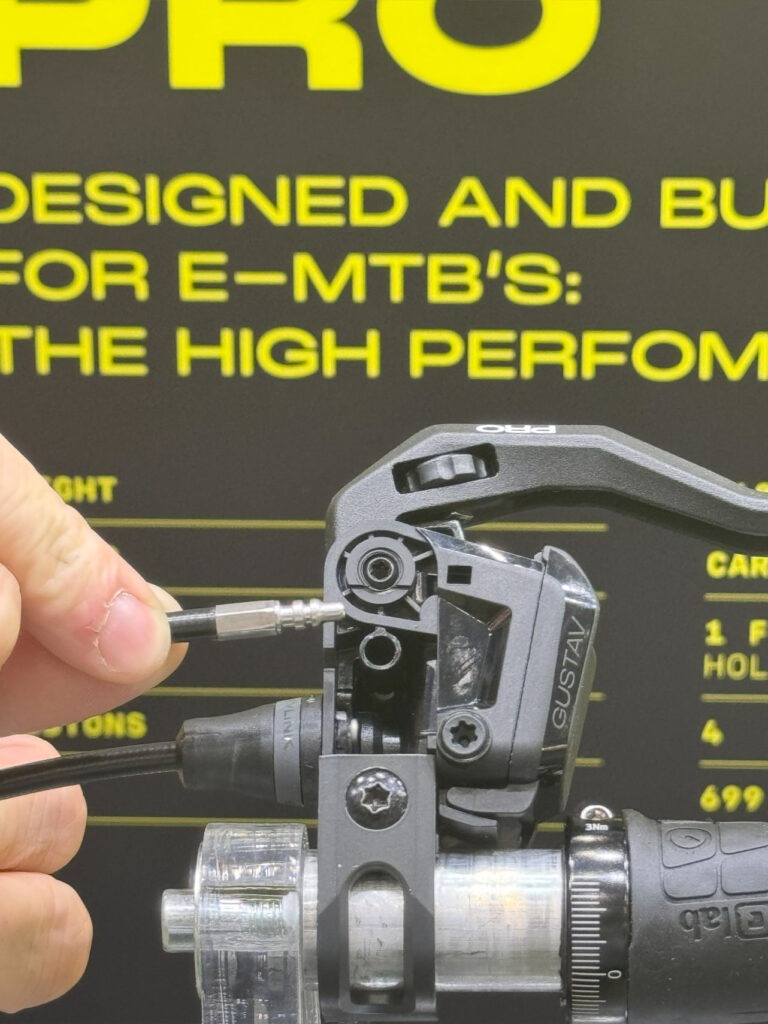
No Bleeding Required
Magura’s new Gustav Pro hydraulic braking system is due to be available in Australia from May 2025. It’s designed as their top of the range enduro and downhill MTB brake.
It features a quick link that’s pressed on at the factory and fully re-usable and means brakes can be serviced with no need to bleed the lines. It has a membrane that keeps the hydraulic brake fluid in place.
The Gustav Pro rotor is 2.5mm thick compared to standard rotors at 2mm. This increases longevity and allows the rotor to run cooler, which also helps with brake pad longevity. They’ve also increased brake pad thickness by 40%. The brakes will retail for A$450 per end plus A$80 per rotor.
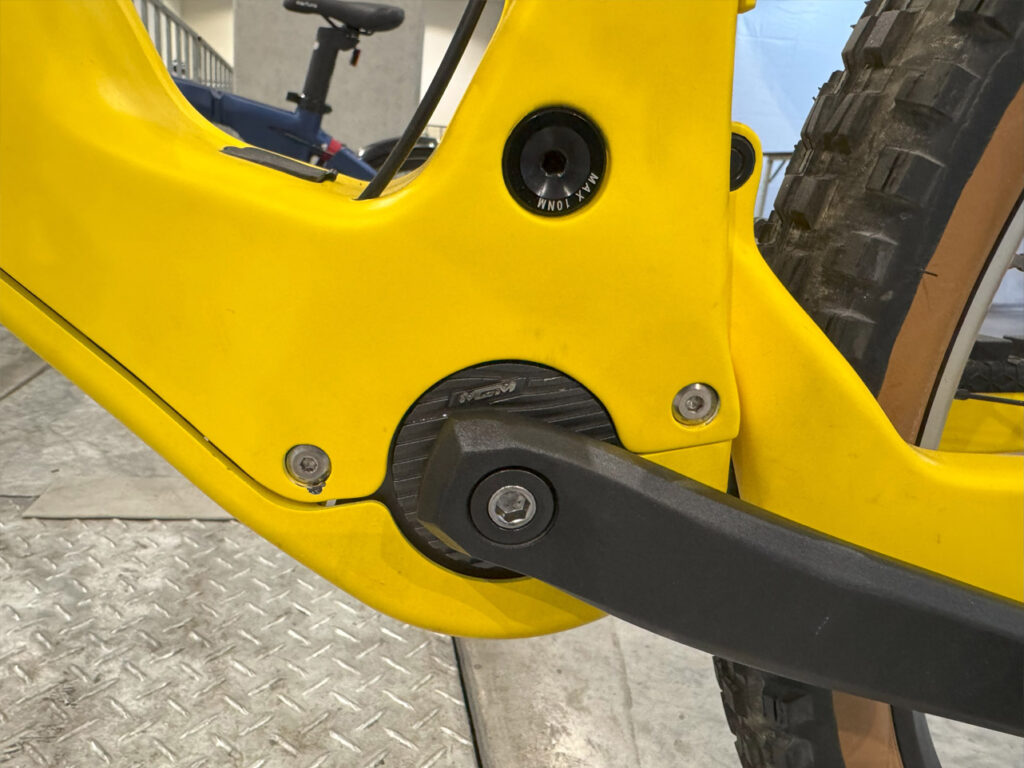
Will This MGM be a Star?
On a small stand at the very far end of the “least” of the three Taipei Cycle halls was this prototype bike by Star Union Wuxing, a factory based in mainland China.
The unsightly gap you can see in the frame was due to a loose cover. The bike itself was a relatively cheap and uninspiring full suspension MTB. The surprising part was the motor hidden inside which they readily admitted was designed as a competitor to the German TQ system that has been used by Trek and others.
There were dozens of competing e-bike drive systems on display at Taipei Cycle. Many of these will never make it to Australia.
I wouldn’t be featuring this bike at all if I hadn’t test ridden it. The motor was remarkably quiet and smooth, with good power and reasonably responsive to changing pedal inputs. They say it gives 85Nm of torque which is more than TQ’s, although the motor is also larger and heavier, at about 2.3kg. They claim a continuous watt output of 250w with a peak of 580w.
A key design challenge for all bicycle electric drive systems is that electric motors work best when spinning fast – thousands or even tens of thousands of rpm (revolutions per minute).
But a typical mountain biker would usually be pedalling at less than 100 rpm. So even if an ebike uses a relatively slow spinning motor, the drive unit has to link these two diverse power inputs via a reduction system. Most systems do this via gears and belts.
MGM stands for “Magnetic Gear System”. It means there’s no physical gear linkage between the motor and the final drive. This is not new technology, but has been difficult to successfully use in ebikes.
Star Union has about 1,300 staff and started making bicycle components in 1989. They started working on e-bikes from 1997. They said they’re talking with major brands including Orbea and Trek about the drive system which will have an ex-factory price of US$700 (A$1,110) for the motor unit, battery and controller.

Scooting Along the Trails
This MTB scooter is sold under other brands than the “AR” that appears on this factory sample. I had a test ride, but just on the show’s test track with no dirt in sight. It felt to have plenty of power and adequate brakes. It’s apparently made by multiple manufacturers using the same parts and drive system.
The frame also sports a large decal saying “Designed in Whistler.”

Non-Rubber Tyres
Retyre is a Norwegian inventor / manufacturer that says it has developed revolutionary injection moulded tyres that don’t use rubber. Instead they use “reusable plant-based thermoplastic elastomers”… I don’t know exactly what that means either!
Although the sample shown here is a general purpose tyre, they say that MTB specific models are coming soon that will have identical performance and compliance with rubber tyres.
Retyre was founded 10 years ago and currently has 57 staff across Norway, USA and China.
Their first product was zip-on tyre tread skins. That product made a splash at the time, but never really took off.
They say their new tyre system allows them to make tyres that are slightly cheaper, slightly more durable and slightly lighter than rubber tyres. They’re not suitable to run as tubeless so every tyre still needs an inner tube.
At the end of its life, the tyre can be shredded and immediately moulded into a new tyre, with no energy or labour intensive processing required.
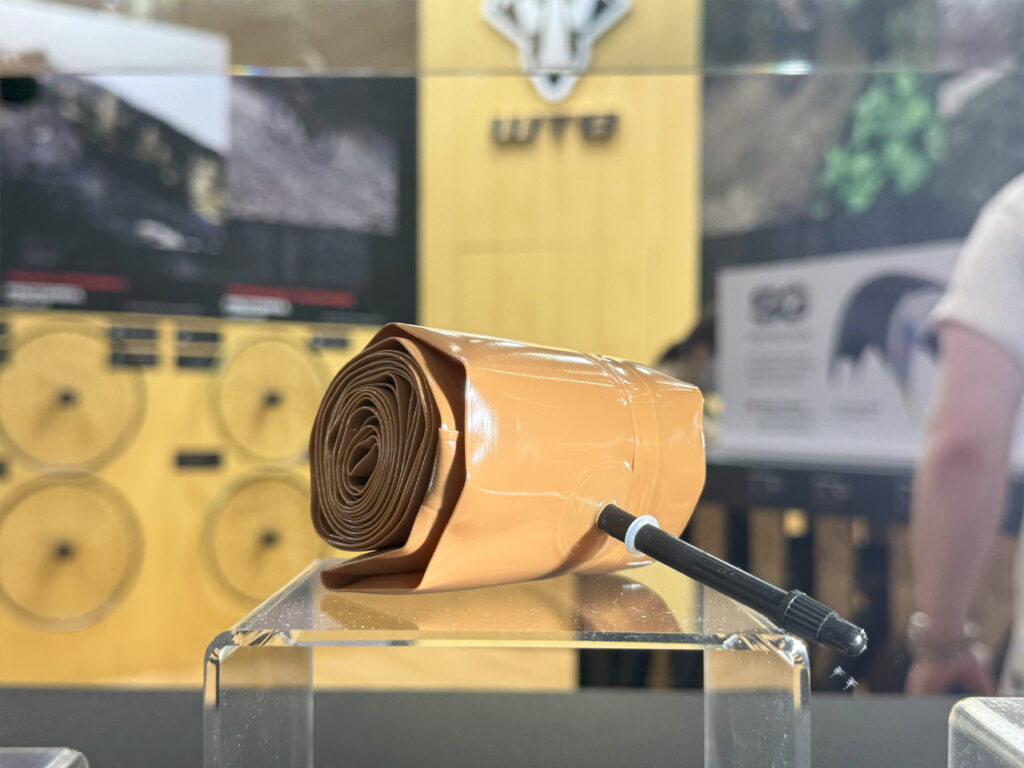
Plastic Tubes Rule!
From just one company displaying tubes like this at Eurobike last year, there were multiple brands including WTB displaying these new style tubes that are far lighter and more compact than traditional tubes.
This Nanno Air MTB tube from WTB comes in 29 and 27.5 inch versions, each with two different widths of 2.5 or 3 inch. There’s also a gravel bike version. WTB says they’re 60% lighter and 1/3rd the size of a standard tube as well as being more durable. They can be repaired and come with two patches per tube.
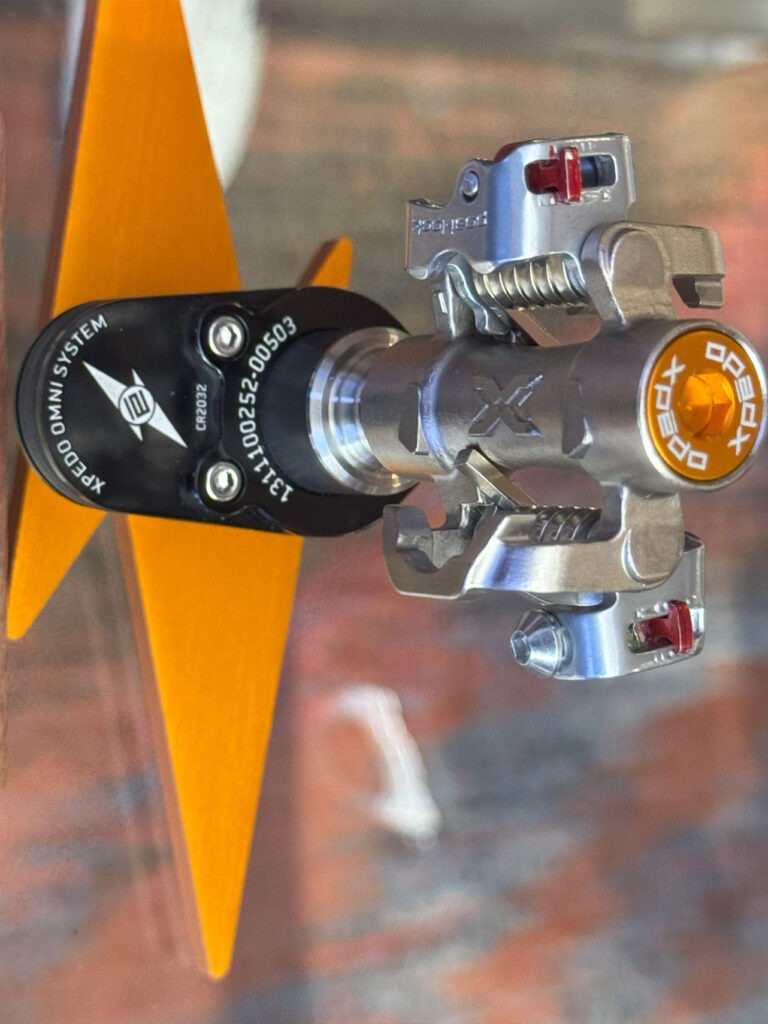
Pedal to the Metal
This is the Xpedo M-Force 8 Omni MTB power meter pedal. Xpedo says it’s better to measure power output as close as possible to the rider rather than at the crankarm, crank spider or hub that other systems use.
Even with the power meters incorporated, these pedals only weigh 321 grams per pair. They have titanium bodies and three sealed bearings.
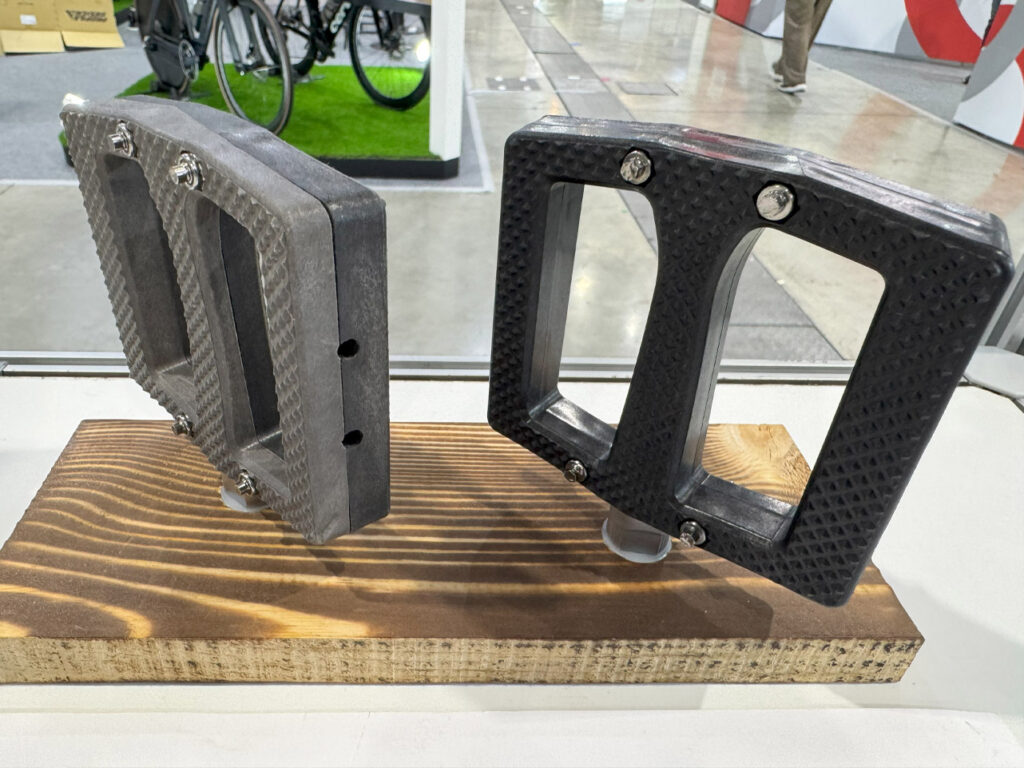
Recycling Theme
There was a big emphasis upon environmental sustainability at many stands at this year’s Taipei Cycle.
This platform pedal from CKC is partly made from rice husks to form a “bio based fibre composite.”
The two halves of each pedal can be separated to remove and replace them if required.
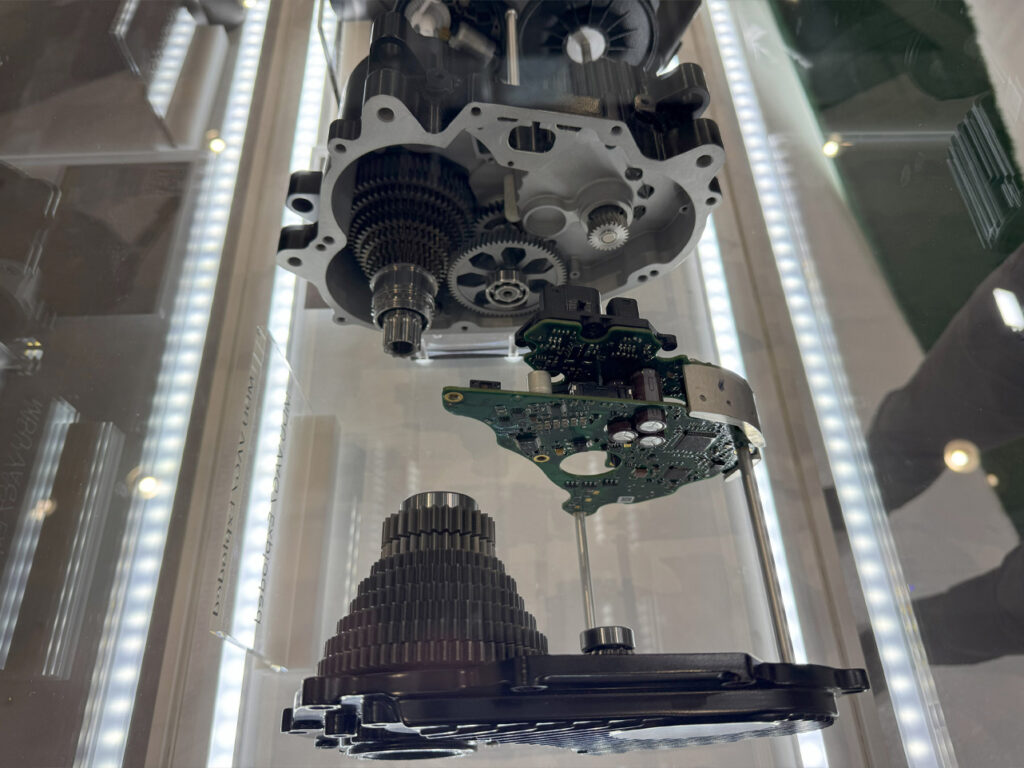
Will Integrated Gearbox Motor Units Take Off?
I was disappointed when I test rode a couple of Pinion integrated gearbox and motor units at Eurobike last year – they were noisier and “clunkier” in some of the changes than I expected.
Pinion has been around almost 20 years and their combined motor/gearbox unit was launched in June 2023. But now a much larger company is also having a crack at this system.
Valeo is a 102 year old French automotive parts manufacturer that’s one of the biggest in the world with over 110,000 staff and over A$30 billion of annual sales.
This model pictured is more suited for cargo bikes but they say a lighter, smaller MTB version is in development now.
They also say that their design is different from the Pinion and claim it to be smoother and quieter when changing gears. But there was no sample to test ride, so I’ll look out for that opportunity in June at Eurobike and hopefully give you an update.
